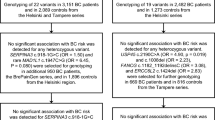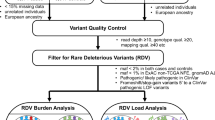Abstract
The tumor suppressor p53 and its negative regulator MDM2 have crucial roles in a variety of cellular functions such as the control of the cell cycle, senescence, genome stability and apoptosis, and are frequently deregulated in carcinogenesis. Previous studies have highlighted the contribution of the common functional polymorphisms p53 p.Arg72Pro and MDM2 309SNP to the risk of both common cancers and Li–Fraumeni syndrome. Their possible role in retinoblastoma has recently been addressed by Castéra et al, who however only studied the MDM2 309SNP. Here, for the first time, we analyzed both single nucleotide polymorphisms (SNPs) in a case–control study of 111 Italian hereditary retinoblastoma patients. We found a significant association of the p53 Pro/Pro genotype with the disease (odds ratio=3.58, P=0.002). The MDM2 309SNP showed a weak negative association of allele G that deserves further investigation. These findings further support the hypothesis that genetic variability of the p53 pathway contributes to the individual susceptibility to retinoblastoma, as shown for Li–Fraumeni syndrome and a variety of non-hereditary cancers.
Similar content being viewed by others
Main
Retinoblastoma (RB, OMIM#180200), the most common primary intraocular malignancy in children, affecting 1:14 000–1:22 000 live births, is caused by biallelic inactivation of RB1.1 In about 40% of patients a germline mutation inactivates one allele and a somatic one the second allele (hereditary RB), whereas in non-hereditary RB, both alleles are inactivated somatically. Although most children with hereditary RB show multiple bilateral tumors, a significant proportion of carriers remain unaffected or only develop unilateral tumors, or benign retinomas.2 Penetrance and expressivity of hereditary RB may depend on the type of inherited mutation, and can vary even within families and among patients with identical mutations.3, 4, 5 This indicates a role of modifiers that may affect genome stability to favor the occurrence of somatic mutations, and/or the apoptotic pathway to induce loss or maintenance of the mutated retinoblasts.
The p53 pathway, the master control system of these processes, is controlled by a feedback autoregulatory loop in which p53 transcriptionally activates MDM2, that in turn functions as a negative regulator by promoting the proteolytic degradation of p53. Interestingly, this circuit can also target pRB to degradation and in physiological condition controls the cell cycle and apoptosis of the retinal cone precursors, from which the RB cell lineage originates.6 In RB, p53 is not usually mutated nor is MDM2 amplified. Rather, the expression of MDM2 is highly induced and represses p53,6 thus leaving ample space for constitutional polymorphism of p53 and/or MDM2 to affect the fate of the RB lineage.
The 72Pro allele of p53 single nucleotide polymorphisms (SNP) (p.Arg72Pro, rs1042522:G>C) features a reduced proapototic activity compared with the 72Arg allele, and together with its more efficient induction of the MDM2 gene and other p53 targets eventually results in attenuation of the p53 pathway.7
The G allele of MDM2 309SNP (c.14+309T>G, rs2279744:T>G), adjacent to p53-responsive elements of the inducible intronic P2 promoter, activates MDM2 transcription8 and results in overdegradation of p53.9 Several studies have highlighted the risk-modifying effect of these polymorphisms in common cancers and the rare Li–Fraumeni syndrome caused by germinal TP53 mutations.10, 11, 12 The possible role of the MDM2 309SNP in RB has only recently been addressed through a family-based approach.13
For the first time we here investigated both SNPs. We took advantage of a sample of 111 RB patients with known germinal RB1 mutation (50% M, 93 bilateral cases, median age at diagnosis 22.75 months (interquartile range, 10.29–37.79)) from the Italian DataBase of Retinoblastoma, referred to the Medical Genetics Unit of Siena since 2003 for germline RB1 mutations testing. Written consent was obtained from all subjects or their legal tutors. Controls were 307 unrelated Italian individuals.
The two SNPs were genotyped on blood DNA using Pyrosequencing, according to standard protocols. PCR and sequencing primers were designed using the PSQ Assay Design Software version 1.0.6 (Biotage AB, Uppsala, Sweden, now Qiagen), and are available on request. Pyrograms were analyzed using the PSQ96MA 2.0.2 software (idem). The association of each SNP and of the combined genotypes were analyzed in a case–control design using logistic regression with Firth's bias reduction procedure to assess their effect on the disease risk.
Allele frequencies of the p53 SNP were Arg 0.68 and Pro 0.32 among RB patients versus 0.78 and 0.22 in controls, those of the MDM2 309SNP T 0.66 and G 0.34 versus 0.59 and 0.41. The genotype frequencies of patients and controls were in Hardy–Weinberg equilibrium for both polymorphisms. The Pro/Pro genotype was significantly disease-associated compared with the Arg/Arg (Table 1a); the heterozygous Arg/Pro was also increased but not significantly. The MDM2 309SNP showed a weak negative association of the G allele; the GT genotype was significant within the Arg/Arg subgroup (Table 1b).
For the first time we show that the association of the Pro/Pro genotype, well known in other cancers, also holds true in hereditary RB. p53 Has a central role as tumor suppressor but is not mutated in RB.14, 15, 16 It has been suggested that RB precursor are intrinsically apoptosis-resistant cells.17 However, there is evidence in mice and humans that the p53 pathway has a central role in regulating the progression of RB cells from quiescent retinoma to overt disease.2, 18 Two features of the p53 72Pro allele can be hypothesized to contribute to this outcome, that is, its increased transcriptional activity on target genes and the weaker interaction with the MDM2 protein, the first by enhancing MDM2 hyperexpression, and the second by downregulating the mitochondrial control of the apoptotic pathway.7
On the other hand, our finding of a weak negative association of the MDM2 G allele is in contrast with reports of its preferential transmission to RB patients,13 modifier role in Li–Fraumeni syndrome9, 19 and association with common cancers.20 Nevertheless, our findings seem plausible, considering that the association only holds in p53-mutated cancers.20 If confirmed in other independent studies, the pattern we report here of positive association of p53 Pro/Pro and negative association of MDM2 GG would depict a new scenario with different functional and therapeutic implications.
References
Knudson, A. G. Hereditary predisposition to cancer. Ann. NY Acad. Sci. 833, 58–67 (1997).
Dimaras, H., Khetan, V., Halliday, W., Orlic, M., Prigoda, N. L., Piovesan, B. et al. Loss of RB1 induces non-proliferative retinoma: increasing genomic instability correlates with progression to retinoblastoma. Hum. Mol. Genet. 17, 1363–1372 (2008).
Klutz, M., Brockmann, D. & Lohmann, D. R. A parent-of-origin effect in two families with retinoblastoma is associated with a distinct splice mutation in the RB1 gene. Am. J. Hum. Genet. 71, 174–179 (2002).
Lohmann, D. R. & Gallie, B. L. Retinoblastoma: revisiting the model prototype of inherited cancer. Am. J. Med. Genet. C. Semin. Med. Genet. 129C, 23–28 (2004).
Sampieri, K., Hadjistilianou, T., Mari, F., Speciale, C., Mencarelli, M. A., Cetta, F. et al. Mutational screening of the RB1 gene in Italian patients with retinoblastoma reveals 11 novel mutations. J. Hum. Genet. 51, 209–216 (2006).
Xu, X. L., Fang, Y., Lee, T. C., Forrest, D., Gregory-Evans, C., Almeida, D. et al. Retinoblastoma has properties of a cone precursor tumor and depends upon cone-specific MDM2 signaling. Cell 137, 1018–1031 (2009).
Dumont, P., Leu, J. I., Della Pietra, A. C. III, George, D. L. & Murphy, M. The codon 72 polymorphic variants of p53 have markedly different apoptotic potential. Nat. Genet. 33, 357–365 (2003).
Iwakuma, T. & Lozano, G. MDM2, an introduction. Mol. Cancer Res. 1, 993–1000 (2003).
Bond, G. L., Hu, W. & Levine, A. A single nucleotide polymorphism in the MDM2 promoter attenuates the p53 tumor suppressor pathway and accelerates tumor formation in humans. Cell 119, 591–602 (2004).
Fang, S., Krahe, R., Lozano, G., Han, Y., Chen, W., Post, S. M. et al. Effects of MDM2, MDM4 and TP53 codon 72 polymorphisms on cancer risk in a cohort study of carriers of TP53 germline mutations. PLoS One 5, e10813 (2010).
Wu, C. C., Krahe, R., Lozano, G., Zhang, B., Wilson, C. D., Jo, E. J. et al. Joint effects of germ-line TP53 mutation, MDM2 SNP309, and gender on cancer risk in family studies of Li-Fraumeni syndrome. Hum. Genet. 129, 663–673 (2011).
Francisco, G., Menezes, P. R., Eluf-Neto, J. & Chammas, R. Arg72Pro TP53 polymorphism and cancer susceptibility: a comprehensive meta-analysis of 302 case-control studies. Int. J. Cancer 129, 920–930 (2011).
Castéra, L., Sabbagh, A., Dehainault, C., Michaux, D., Mansuet-Lupo, A., Patillon, B. et al. MDM2 as a modifier gene in retinoblastoma. J. Natl Cancer Inst. 102, 1805–1808 (2010).
Kato, M. V., Shimizu, T., Ishizaki, K., Kaneko, A., Yandell, D. W., Toguchida, J. et al. Loss of heterozygosity on chromosome 17 and mutation of the p53 gene in retinoblastoma. Cancer Lett. 106, 75–82 (1996).
Gallie, B. L., Campbell, C., Devlin, H., Duckett, A. & Squire, J. A. Developmental basis of retinal-specific induction of cancer by RB mutation. Cancer Res. 59, 1731s–1735s (1999).
Sampieri, K., Amenduni, M., Papa, F. T., Katzaki, E., Mencarelli, M. A., Marozza, A. et al. Array comparative genomic hybridization in retinoma and retinoblastoma tissues. Cancer Sci. 100, 465–471 (2009).
Chen, D., Livne-bar, I., Vanderluit, J. L., Slack, R. S., Agochiya, M. & Bremner, R. Cell-specific effects of RB or RB/p107 loss on retinal development implicate an intrinsically death-resistant cell-of-origin in retinoblastoma. Cancer Cell 5, 539–551 (2004).
Nork, T. M., Poulsen, G. L., Millecchia, L. L., Jantz, R. G. & Nickells, R. W. p53 regulates apoptosis in human retinoblastoma. Arch. Ophthalmol. 115, 213–219 (1997).
Bougeard, G., Baert-Desurmont, S., Tournier, I., Vasseur, S., Martin, C., Brugieres, L. et al. Impact of the MDM2 SNP309 and p53 Arg72Pro polymorphism on age of tumour onset in Li-Fraumeni syndrome. J. Med. Genet. 43, 531–533 (2006).
Hu, Z., Jin, G., Wang, L., Chen, F., Wang, X. & Shen, H. MDM2 promoter polymorphism SNP309 contributes to tumor susceptibility: evidence from 21 case-control studies. Cancer Epidemiol. Biomarker. Prev. 16, 2717–2723 (2007).
Author information
Authors and Affiliations
Corresponding author
Rights and permissions
About this article
Cite this article
Epistolato, M., Disciglio, V., Livide, G. et al. p53 Arg72Pro and MDM2 309 SNPs in hereditary retinoblastoma. J Hum Genet 56, 685–686 (2011). https://doi.org/10.1038/jhg.2011.82
Received:
Revised:
Accepted:
Published:
Issue Date:
DOI: https://doi.org/10.1038/jhg.2011.82
Keywords
This article is cited by
-
A Functional Polymorphism (rs937283) in the MDM2 Promoter Region is Associated with Poor Prognosis of Retinoblastoma in Chinese Han Population
Scientific Reports (2016)
-
Association of p53 rs1042522, MDM2 rs2279744 and p21 rs1801270 polymorphisms with retinoblastoma risk and invasion in a Chinese population
Scientific Reports (2015)



